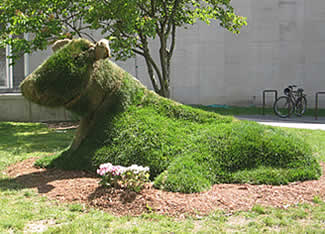
Community projects:
Videos:
Examples
- Bluegrass Lane stairs and doorway
- Sod sofa at NYS Fairgrounds
- Longwood Gardens installation
- Bluegrass Lane spiral
- Sod cow
Across
the world, there are prehistoric remains of humans and
our impact on the earth. Mounds, patterns, and interesting
designs can be found on many continents. They are intriguing
reminders of people who lived here centuries or millennia
before us.
Turf- or Sod-works are created from grass or moss and
soil. This type of art has roots (if you will pardon
the pun!) in the Land Art movement (also known as the
Earthworks or Earth Art movement) that emerged in the
late 1960s and early 1970s. During this exciting period,
landscape and the work of art began to be viewed as
linked. Sculptures were not just placed in the landscape;
rather the landscape became the very means of their
creation. These works often existed in the open, located
well away from communities, and were left to change
under natural conditions. Many of the first works were
created in the deserts of Nevada, Utah, New Mexico,
and Arizona. They did not, or were not meant to last,
and now exist only as recordings or photos.
Check
out the Wikipedia
overview of Land Art, with its many links to images.
A quick visual overview of earth art and earthworks
which also includes “non-living
examples”.
Works
made from the earth are changing the way in which people
view art, and often are used to promote environmental
awareness. These works may be created on waste sites,
and may draw attention to land reclamation and urban
restoration efforts.
Recent earth artists have worked with soil, sod, or
moss to create forms that may be intimate and small,
or large and multi-acre. They may be cut out of the
earth, or formed with soil. They may give a nod to the
past, or they may be cutting edge and contemporary in
design. Some examples include labyrinths and mazes,
animal and human forms, geometric shapes, and furniture.
In our activities, we focus on sod furniture, since
it is both functional and ornamental, is relatively
easy to make, and can result in terrific public art
that also provides a hang out spot for youth in the
community.
Books:
- Perfect: Mowing Techniques for Lawns, Landscapes, and Sports. Mellor, David R. 2001.Wiley & Sons Inc.
- Lawnscapes: Mowing Patterns to Make Your Yard a Work of Art. Parfitt, David 2006. Quirk Books.
- Crop Art and Other Earthworks. Herd, Stan 1994. Harry N. Abrams Publishers.
- Crop Circles: Art in the Landscape. Pringle, Lucy 2007. Frances Lincoln.
- HGTV at Home: Sod Sofas - Landscape architect Greg Tate demonstrates how to build a sod sofa for your lawn
- Basket Weave Sod Sculpture - Sod and stone sculpture based on Native American basket design.

